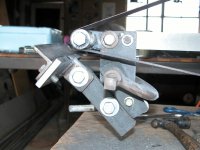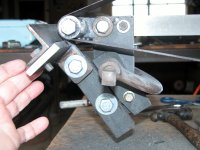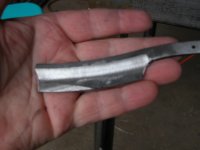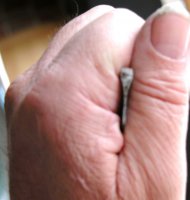There was a recent discussion in another thread about heat treating and I thought it would be good to have a dedicated thread to the subject along with forging, etc. The subject does not have to be strictly razor related, but of course that is how we all got here.
OK, so the quick and dirty on heat treating carbon steel is that when the steel is heated above it's critical temperature (in excess of 1400 F depending on composition) the lattice structure changes from bcc (body centered cubic) to fcc (face centered cubic) The fcc can hold more carbon in the lattice than bcc steel. When the steel is quenched it turns back to bcc, but if done quickly enough the carbon remains trapped in a lattice structure that does not have room for it. This causes stress in the lattice and makes the steel hard (martensite) The steel is brittle hard at this point and can fracture easily, so the steel is tempered by heating (350-500 f depending on the final use) The tempering allows some of the carbon to move out of the lattice reducing some of the the strain and making the martensite softer and less brittle.
This is a very crude description, but I did not want to write a book here. A good book on the subject is "Steel Metallurgy for the Non-Metallurgist" John D. Verhoven
OK, so the quick and dirty on heat treating carbon steel is that when the steel is heated above it's critical temperature (in excess of 1400 F depending on composition) the lattice structure changes from bcc (body centered cubic) to fcc (face centered cubic) The fcc can hold more carbon in the lattice than bcc steel. When the steel is quenched it turns back to bcc, but if done quickly enough the carbon remains trapped in a lattice structure that does not have room for it. This causes stress in the lattice and makes the steel hard (martensite) The steel is brittle hard at this point and can fracture easily, so the steel is tempered by heating (350-500 f depending on the final use) The tempering allows some of the carbon to move out of the lattice reducing some of the the strain and making the martensite softer and less brittle.
This is a very crude description, but I did not want to write a book here. A good book on the subject is "Steel Metallurgy for the Non-Metallurgist" John D. Verhoven


 There is a video of me demonstrating it somewhere on the internet. I'll try to find it tomorrow. My pre HT blanks are actually parallel sided within a few thousandths. The end view may look as if the mid is thinner, but that is just some edge rounding
There is a video of me demonstrating it somewhere on the internet. I'll try to find it tomorrow. My pre HT blanks are actually parallel sided within a few thousandths. The end view may look as if the mid is thinner, but that is just some edge rounding



